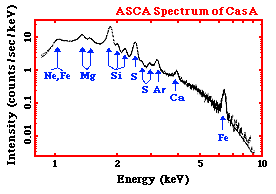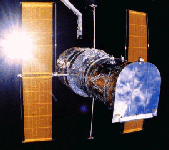European Space Agency to Launch XMM
European Space Agency Launches XMM
| 10 December 1999 |
Europe's Latest Telescope, Chandra's Sister
In July 1999, NASA launched an extraordinary X-ray telescope named Chandra. At a distance one-third of the way to the moon, the telescope's deep, lonely orbit gives it an unimpeded view of distant exploding stars and clusters of galaxies.

Credit: ESA
Now Chandra has company, a European satellite called XMM that is every bit as impressive. The two satellites are like equally talented sisters who may at times compete for a share of the spotlight but ultimately work hand-in-hand in uncovering the most violent and mysterious phenomena in the universe.
XMM (short for X-ray Multi-Mirror) will be a prime tool for astronomers studying black holes, star formation and much more. Funded and built largely by the European Space Agency (ESA), XMM was launched on December 10 and, over the next two months, will undergo a series of calibration tests before opening its hatch to exploration. First light is expected in January.
 Credit: ESA |
A Telescope the Size of a Tennis Court
From its first incarnation, XMM was designed to complement Chandra. For example, Chandra's sensitive cameras produce sharp images of newborn stars and supernova remnants. XMM's huge collecting area, in turn, captures enough X-ray photons to reveal the temperature and velocity of the gas in these objects.

|
XMM's total X-ray collecting area, divided among three separate telescopes, is nearly the size of a tennis court, 120 square meters - yet the telescopes themselves are only 70 centimeters wide. Sound impossible? The secret is in the design.
Each sleek, barrel-shaped telescope has 58 wafer-thin mirrors curved into cylinders and nested within each other like Russian dolls. Each mirror sits 25 microns from its neighbor, about a quarter the width of a human hair.
The X-ray Rainbow
The other two X-ray telescopes split the number of photons. Half the photons head toward the camera and half go directly to a device that analyzes the "colors" of the X-rays.
Just like the spectrum of visible light ranges from red to blue, the X-ray spectrum is made up of different colors. Each color corresponds to a different wavelength or energy of light. This is also true of visible light - for example, red light has a longer wavelength than blue light.
 |
The analysis of the colors of light is called spectroscopy. The analysis of the colors of X-ray light is similarly called X-ray spectroscopy. Different gases at different temperatures produce a unique set of chemical fingerprints, giving each element its own distinctive spectrum. By studying optical spectra of sunlight, we can learn about the different elements that form the sun. Likewise, the X-ray spectra of supernova remnants reveal all the elements a star produced before its final fiery stellar explosion. The X-ray spectra of the remains of a star also reveal all the elements that were caught in the path of the shockwave of the explosion. Some of these are the elements the star produced before its death, but others (those heavier than iron) are the elements created in the extreme heat and pressure of the explosion.
Telescopes used from spectroscopy do not produce the kind of images that we see from the Hubble Space Telescope, however, the kind of "images" they do produce -- charts and graphs -- are just as valuable. This is why X-ray astronomers need both Chandra and XMM. The two satellites will work together just as the the telescopes Hubble and Keck do now. Hubble produces great images, and Keck (a ground-based telescope in Hawaii) produces corresponding spectra.

|  |
Chandra will produce sharper images than XMM; its angular resolution is as low as 1 arc second, compared to XMM's 6 arc second. XMM, however, will generate stronger spectra. This is because its larger collection area can collect more photons than Chandra can, and with more photons (like data points) the spectra will be more statistically significant.
By the way, even through X-rays can travel billions of miles through the universe, X-ray photons cannot penetrate the earth's atmosphere. They come to a cold stop before reaching us on the ground. As a result, both Chandra and XMM must be place in space, above the atmosphere, to collect photons and view the X-ray universe.
XMM's Bonus Telescope, A Mini-Hubble
Wait, there's more! XMM has a fourth instrument, an optical-ultraviolet (UV) telescope called the Optical Monitor. This is like a scaled-down version of the Hubble Space Telescope. The telescope has a 30-centimeter aperture, which means the viewing area is 30-cm wide. But because it's above the atmosphere, the telescope has the power of a 4-meter-wide earth-bound telescope.
This Optical Monitor is handy for viewing the optical and UV counterparts of X-ray sources. For example, the gas and miscellaneous star-stuff that spirals into a black hole can glow in X-rays as well as optical and UV light. XMM can view this simultaneously across wavelengths, learning more about the bizarre physics behind a black hole.
In total, XMM has one telescope dedicated completely to images (via the European Photon Imaging Camera), two telescopes that produce X-ray images and spectra (the latter via the Reflection Grating Spectrometer), and one optical-UV telescope (the Optical Monitor).
What XMM Will Actually Look At
Astronomers around the world are so excited about XMM because the satellite observes so many different types of objects and events. They are listed below - details of each of these topics can be found at http://heasarc.gsfc.nasa.gov/docs/xmm/science_top1.html
- Cosmic X-ray background radiation
- Elliptical galaxies and clusters of galaxies
- Normal and starburst galaxies
- Active galactic nuclei and quasars
- Stellar black holes, neutron stars, pulsars
- Supernova remnants
- The hot phase of the Galactic ISM
- Cool gas
- Stellar coronae
- Comets

